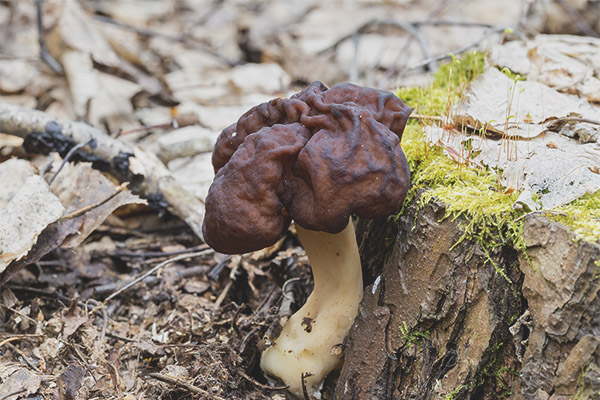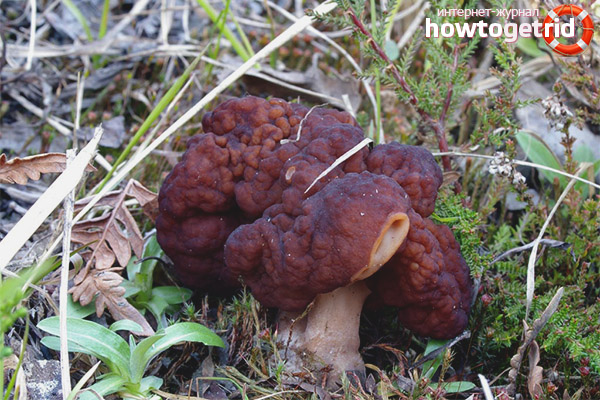The content of the article
In addition to poisonous mushrooms and suitable for food, there are also those around which there are disputes, to which category they belong. Catch common (Gyromitra esculenta) - just such a mushroom. It belongs to the genus Strochkov and belongs to the Discinov family.
It is a marsupial mushroom. Some reference books identify it as suitable for use in the preparation of some dishes, but with limitations, others suggest the presence of a toxin dangerous to life and health. In English-speaking countries, this mushroom, due to its strange species, has been named “mushroom-brain”, as well as “elephant ears”. In Russia, it is known by the name of spring line, jerk or edible line.
Mushroom Description
This mushroom, interesting by its appearance, has a number of features:
- A hat is what caused the mushroom to get so many names. It is like a human brain or a walnut. There are cavities in it.The cap has an interesting and catchy irregular shape and surface, mottled with deep wrinkles. Color brown with a chocolate tinge. The mushroom is quite large, some specimens grow to 12 cm.
- Leg line is white or cream-colored, narrowed at the beginning, wide and short. Its length is on average 4 cm, and its width is about 3 cm. Outside, the leg is covered with grooves along the length, inside - the whole is hollow.
- The structure of the pulp is quite fragile, in color it is whitish or creamy. It is very easy to crumble with your hand. The taste is quite pleasant, the smell is remotely similar to almond nut.
- Spores are bright, in the shape of an ellipse, hidden in cylindrical bags.
As can be understood from its name, the spring line forms its fruit bodies in early spring - in the southern regions already in March, and to the north - in April or May. The mushroom is saprotrophic, that is, it feeds on organic matter. It can be found on soils with sand, along roads, on burns or felled glades. Prefers coniferous plants, but can occur in poplars.
Spring line grows in Europe, North America, Ireland and England.That is, the fungus is widely distributed.
Peculiarities of eating
Europeans without any restrictions used for the preparation of various dishes line ordinary. But for the last hundred years, mycologists have been arguing about how poisonous this mushroom is. However, many people continue to collect and eat it. The poison found in the fungus is called "giromitrin." It is not neutralized by cooking or other heat treatments. The only way to make a mushroom safe is to dry it. Hiromitrin has a negative effect on the human liver and nervous system.
Such an ambiguous position about the edibility or inedibility of the fungus due to the fact that its toxicity depends on the region of growth. Much poison is found in lines from western Europe, especially from Germany. They are dangerous to eat and can cause severe poisoning. In ordinary lines from the eastern regions, as well as growing Russia, the content of poison is minimal and they are safe. Cases of poisoning are also found in these areas, but no fatal episodes have been recorded.In North America and Europe, this mushroom is classified as safe, and it is successfully used to prepare various dishes. The exception is Italy - there it is not allowed for sale.
Before there is an ordinary line, it must be properly prepared - drying for a long time, cooking at least 2 times, with water replacement and thorough washing in the process. Mushroom is used for cooking soups, frying, stewing or as a filling in pies. It is not recommended to eat it regularly and in large portions.
First aid for poisoning
The state of poisoning when using an ordinary line is called "giromitrin syndrome." The poison contained in the body of the fungus, and is in chemical compounds, and in a free state. Once in the stomach, the substance gyromitrin is converted into other compounds that disrupt the metabolism of proteins and carbohydrates in the body. They also negatively affect the processes of intracellular oxidation. Most affected by the effects of poison are the kidneys and the liver.
It is possible to poison yourself with an ordinary line in the following cases:
- If the mushroom is consumed raw, it is also difficult to boil or dry.
- The use of water obtained during cooking is absolutely impossible to use, because all toxins are concentrated there.
- Constant use of the fungus in food - poison has a cumulative effect and is retained in the body.
- Individual intolerance of the fungus, even in small quantities.
The first signs of poisoning manifest themselves within a day, but not earlier than 3 hours after ingestion. Victims complain about:
- pain in the stomach;
- nausea and vomiting;
- loose stools.
Medical assistance should be provided immediately, because on the second day there is a malfunction of the liver, as well as kidney damage. The development of renal-hepatic failure. Next - hepatitis and nephrosis. Without qualified assistance, there is then the possibility of a coma and a direct threat to life and health.
First aid is in such activities:
- gastric lavage;
- reception of activated carbon or other sorbents;
- use of diuretics.
After rendering first aid, it is necessary to urgently call an ambulance. If the poison has already spread throughout the body and began to influence the internal organs, then the person will be taken to the hospital for more serious procedures.
Other types of lines
In addition to the line of an ordinary, there is a high probability of meeting a line of autumn (a line of horned or lope). It is most widely distributed in various regions of Russia. As the name implies, unlike the spring line, this mushroom throws fruit bodies in the fall. This mushroom is poisonous and not edible. The hat looks like three conjoined horns, painted brown. But as it gets older it becomes almost black. Its surface resembles velvet, and the maximum size reaches 10 cm. The leg is light and short. These mushrooms are single individuals, and if they form groups, they are not large. There are both in coniferous and deciduous forests. They like rotting fallen trees and stumps, but just grow in the soil too.
You can confuse it with an edible line, a mushroom called a giant line (also known as a giant). Its cap is covered with folds, fibrous in structure, brown in chocolate in color. Its average size is 10 cm, but it can reach up to 30 cm, which is what the name of this mushroom says. The foot is small and most often hidden under the cap.The period of fruiting in these mushrooms, as in the ordinary line, is in spring. They love birch forests and soils with sand. They can grow both in groups and individually. Raw to eat these mushrooms is deadly dangerous, but in some countries they are eaten after heat treatment. Basically, the gigantic line is recognized as a poisonous mushroom.
Similar types of mushrooms
It is easiest to confuse the fungus with a common edible morchella (Morchella esculenta). This is also a dangerous factor, because beginner mushroom pickers can use a line, thinking that they are dealing with edible forest fungus. The difference lies in the hat, resembling an egg and a paler color in the latter. Morel edible grows near deciduous trees and shrubs, including in ravines. Morels prefer soil with humus.
In addition to edible morel, there is often another species suitable for human consumption - the morel is conical. You can find them in the ravines and hollows, when the snow in the forest has not yet descended. They grow in groups, mushrooms, as a rule, stand in rows. His hat is more elongated, shaped like a cone.Unlike morel edible, he also prefers open places such as forest glades, sandy soil along paths and roads. Distributed in a mixed forest. These two fungi do not have strong taste differences, their flavor is also similar. The fungal body of the conical morel is slightly drier, and after heat treatment it becomes harder and has a specific crunch.
In the forest, there is also another representative of morels, a morel cap. They love sunny open spaces - meadows, roadsides, cuttings and burning. Appear in May and grow in large groups. The maxi hat has a very specific look, so it is quite difficult to confuse it with other morels. The thick leg, which constitutes almost the entire mass of the fungus, does not have a strong odor, but in the small hat the whole flavor of the fungus is concentrated. However, compared with other types of morels, the flavor is still not as strong. It is important to remember that the morels on the cut will always be hollow - and the cap and leg.
Since many species of mushrooms resemble each other and not all of them are edible, one must be very careful in the forest. In case of any doubts, it is better to leave the mushroom in place and not to take it to the basket.In order to eliminate the toxic effect on the body of an ordinary line, it is recommended to assemble it with caution. Beginners should not touch at all, let alone taste this mushroom. There is a great danger to collect it in the wrong place and at the wrong time, which will endanger health.
Video: line ordinary (Gyromitra esculenta)













To send